How to Use the DeMarker Oscillator in Trading
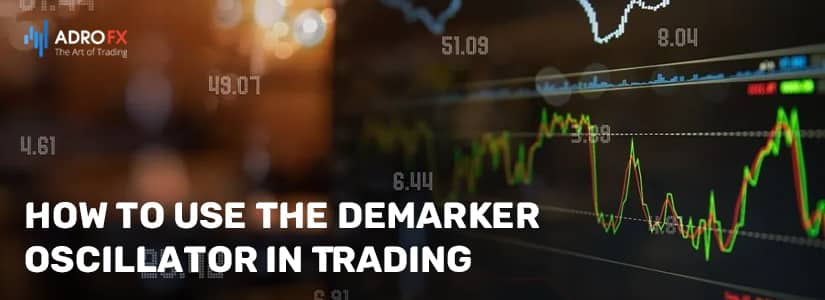
Almost all indicator strategies are based on the complex application of analytical tools. Today we will talk about the Thomas DeMark oscillator (DeMarker), which can be an effective addition to any trading strategy.
What is the DeMarker Oscillator?
The DeMarker indicator was developed by Thomas R. DeMark, a prominent trading theorist, and practitioner, and is described in his book The New Science of Technical Analysis.
DeMark's aim was to create an overbought and oversold indicator by the demand dynamics, which would also show the degree of risk of buying and selling. The new indicator wasn't supposed to have any typical disadvantages of similar tools. DeMark's indicator shows the possible change of the trend when the price approaches its extremums and is built on the principle of comparing the maximum of a certain interval with the maximum of the previous period.
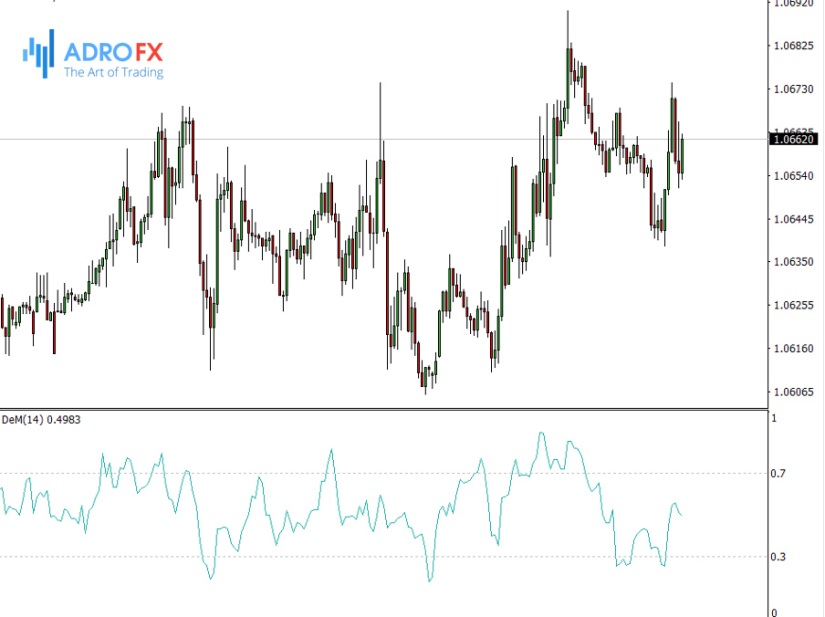
DeMarker's formula is quite complicated and contains several actions. First, the DeMax i index of maxima is calculated, which demonstrates how much the current maximum is higher than the previous one.
After the calculation of lows and highs the DeMarker i indicator is determined by the formula DMark(i) = SMA(DeMax, N)/(SMA(DeMax, N) +SMA(DeMin, N)), where SMA is a Simple Moving Average, N - number of MA periods.
Originally DeMarker's standard period is 13 days, but the author has described this indicator as effective for other periods. In the trading terminals standard period often equals 14. On longer DeMarker periods you can determine the long-term trend, shorter periods are used to open positions by trend.
The preset limits of the overbought and oversold oscillators are 0.7 (70%) and 0.3 (30%), but they can also be reset for a particular strategy, though it is not recommended for beginners:
The DeMarker Oscillator Signals
DeMarker generates the following basic forex trading signals, relying on which you can conduct various strategies: a breakout of resistance/support levels, exiting the oversold and overbought area, divergence, and pattern formation.
The overbought and oversold areas of the indicator are located at the 0.3 and 0.7 levels. Accordingly, crossing the level of 0.7 downwards by the indicator may be a sell signal, and crossing the level of 0.3 upwards may be a buy signal.
Divergence is a classic oscillator signal for forex, it is used very effectively with DeMarker as well. If prices renew maximums and DeMarker shows a new maximum below the previous one, it is a bullish divergence, which indicates an imminent change of trend from upward to downward. Conversely, if prices are making a new low and DeMarker is showing a higher low than the previous one, it is a bearish divergence, indicating that prices are beginning to rise.
In addition, the indicator can show a triple divergence, when the divergence is marked at three extrema in a row, and this signal is considered more accurate than a "normal" divergence. On the chart of the Demark indicator, trend lines are indicated, which are built on the highs and lows. When the bottom support line is broken out, it can be a signal to sell. When the upper resistance line is broken out, it can be a signal to buy.
It also forms classic graphical patterns on the chart - Triangle, Head and Shoulders, Flag, Wedge, and others. The interpretation of these patterns is different from the interpretation of patterns on the price chart, so to work with them, the trader must practice on a demo account and have sufficient experience in forex trading.
DeMarker Oscillator-Based Trading Strategies
The DeMarker indicator is actively used in many forex strategies. It can be used to predict price dynamics in both short and long periods. Over long periods, it helps identify the main trend and filter out false signals.
This oscillator can be used with other DeMark`s indicators, particularly with REI (Range Expansion Index), but more often it is used with different types of Moving Averages.
For example, DeMarker is used in a strategy with a Simple Moving Average. The strategy is implemented in a 15-minute time frame. A buy position is opened when the DeMarker with values between 0 and 0.3 moves out of the oversold area and the SMA should point upwards. A sell position is opened when the DeMarker ranges from 1 to 0.7 and the SMA is directed downwards:
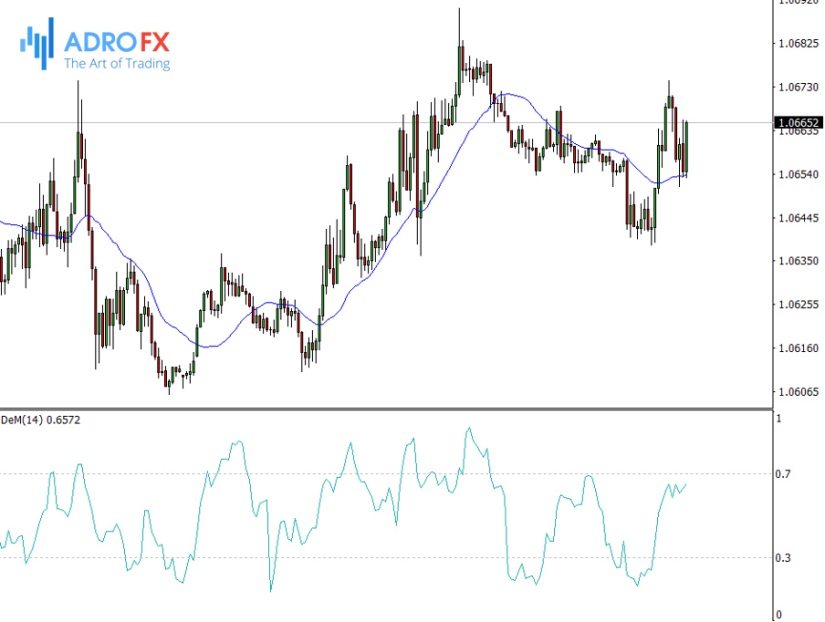
In one strategy, the Exponential Moving Average with a period of 60 is used together with the DeMarker indicator on a pronounced trend. The price should be below the signal EMA, directed downward. The signal to open a sell position is when DeMarker reaches the overbought area and crosses the 0.7 level.
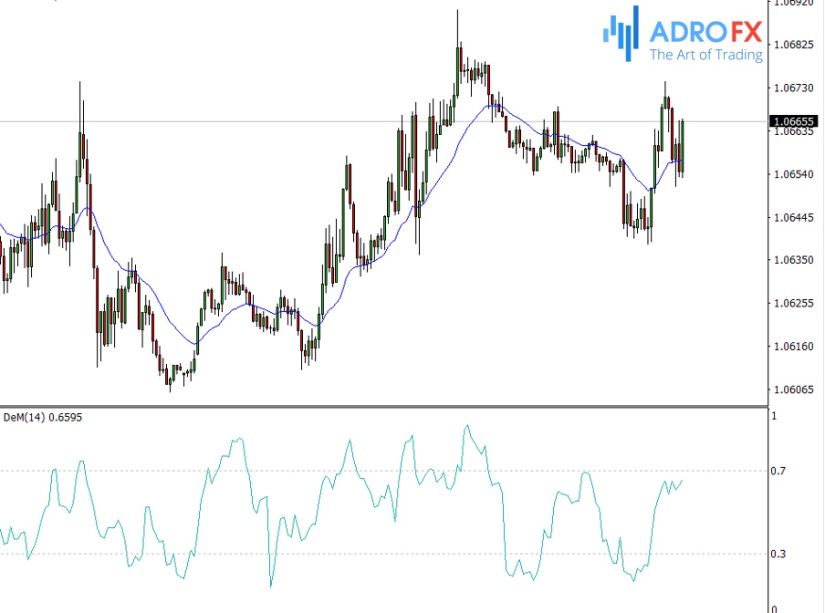
On the contrary, DeMarker's entry into the oversold area with the crossing of 0.3 and the placement of the EMA pointing upwards is a signal for the opening of a buy position.
In a strategy where the MACD and the DeMarker are used, these indicators complement each other. The MACD shows the extremes, with the fast and slow Moving Averages working in it. The fast Moving Average assesses the short-term trend, the slow one assesses the long-term trend, and the divergence between them confirms the trends.
DeMarker in this strategy is necessary to accurately determine entry points. Sell orders are opened when the DeMarker oscillator is in the overbought area and the MACD shows the maximum value.

The other strategy uses the ZigZag indicator in addition to the DeMarker and MACD. It is conducted by extremes, cutting off insignificant price readings. ZigZag values, MACD histogram peaks, and overbought or oversold areas coincide. Positions are opened on the location of overbought or oversold areas marked by the DeMarker indicator. Other indicators confirm this signal.
DeMarker is a popular oscillator, so it has many different modifications, which are used in various strategies, such as the Cronex T DeMarker version and the Heikin Ashi Smoothed indicator.
Heikin Ashi Smoothed indicator is a modification of the standard Heikin Ashi, in particular, it has the ability to change the parameters of Moving Averages and methods of their averaging. This increases the sensitivity of the indicator when tracking long-term trends, as well as when tracking small price fluctuations. Cronex T DeMarker is a more complex modification of DeMarker, which is represented as a histogram of different colors, which is built according to the indicators of two Moving Average lines.
In the strategy, the signals to open positions are given by Heikin Ashi Smoothed, and the indicator serves as their confirmation. The strategy is implemented in time frames from M15 to H4. In the settings of the Heikin Ashi Smoothed, the MaPeriod parameter is set to 12, the DeMarker parameter is set to 36.
Buy orders are opened when the Heikin Ashi Smoothed shows green candles below the price, indicating that the trend is trending upwards. At the same time on this type of oscillator, the blue line of the Cronex T DeMarker crosses the multicolored line from below to above and the indicator forms candles above the zero line.
Accordingly, if the Heikin Ashi Smoothed indicator shows red candles above the price, it indicates the formation of a downtrend and is a signal to sell. The signal is confirmed by the blue line of the Cronex T DeMarker crossing the multicolored line from the top downward.
DeMarker can be used in strategies with the very popular Stochastic indicator. This uses the DeMarker with a very long period to determine the trend as accurately as possible. Stochastic is used to enter the trend at the end of a period of price correction, taking into account the %K - its fast and %D - its slow lines.
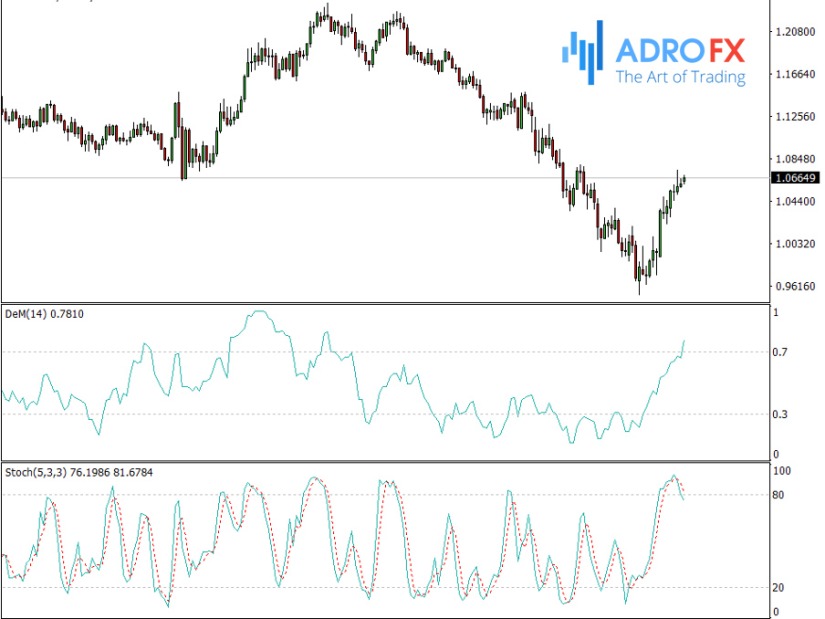
For example, if the DeMarker period is set to 50, the signal to open positions will be an exit of the indicator from zone 0.5. Stochastic is set with the following parameters: %D - 6, %K - 20, and deceleration - 5. According to Stochastics, a relatively low price is determined for an uptrend and a relatively high price for a downtrend. The first signal for both selling and buying will be the price movement back in the direction of the main trend after the correction is exhausted. If DeMarker is placed below 0.5, the main line of the Stochastic is moving above the value of 70 and the signal line is placed below the main line - this is a signal to sell.
Tips For Efficient Use of the DeMarker Oscillator
According to statistics, the use of DeMark's indicator for the analysis of base currency pairs' charts allows us to get up to 70% of accurate signals. This suggests that more successful trading will require the use of certain filters, which may be trend indicators or a system of Price Action candlestick analysis. The Martingale method is also acceptable, but only on the condition of correct capital management calculation in accordance with capital management norms. In this case, the recommended amount of the starting investment should be about 0.5% of the deposit. Using other oscillators as filters are not recommended.
The DeMarker indicator is an effective analytical tool that will allow everyone to benefit from trading forex. The main thing is the correct setting of periods and the correct choice of a financial instrument. The comprehensive application of the DeMarker oscillator in the trading system will increase trading results. It is important that this indicator is the only oscillator in the strategy. Otherwise, trading signals will appear very rarely, while their quality will remain at the same level.

About AdroFx
Established in 2018, AdroFx is known for its high technology and its ability to deliver high-quality brokerage services in more than 200 countries around the world. AdroFx makes every effort to keep its customers satisfied and to meet all the trading needs of any trader. With the five types of trading accounts, we have all it takes to fit any traders` needs and styles. The company provides access to 115+ trading instruments, including currencies, metals, stocks, and cryptocurrencies, which make it possible to make the most out of trading on the financial markets. Considering all the above, AdroFx is the perfect variant for anyone who doesn't settle for less than the best.









